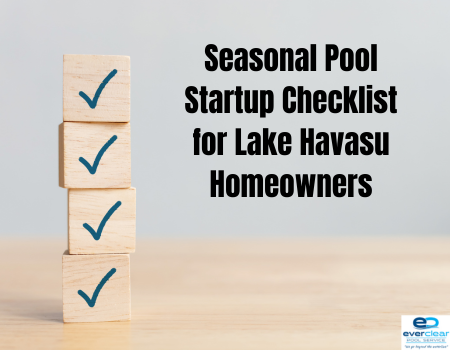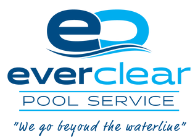 When spring transitions into the scorching summer months in Lake Havasu, pool owners know what that means; it’s time to get the backyard oasis ready for action. But starting up a pool after months of cooler temperatures isn’t as simple as removing the cover and taking a dip. Desert environments like Lake Havasu present unique challenges for pool care, from intense sunlight and rapid water evaporation to mineral buildup and shifting pH levels.
When spring transitions into the scorching summer months in Lake Havasu, pool owners know what that means; it’s time to get the backyard oasis ready for action. But starting up a pool after months of cooler temperatures isn’t as simple as removing the cover and taking a dip. Desert environments like Lake Havasu present unique challenges for pool care, from intense sunlight and rapid water evaporation to mineral buildup and shifting pH levels.
A proper pool opening checklist not only ensures crystal-clear water but also helps extend your pool’s lifespan, saving you money and effort all season long. Here’s a practical, step-by-step Arizona pool startup checklist to help you transition seamlessly from spring to summer.
Seasonal Pool Startup Checklist
1. Start with a Clean Slate
Before touching the water chemistry, begin with a thorough clean-up:
- Remove the pool cover carefully to avoid dumping debris or stagnant water into the pool. Lay it out to dry, then clean and store it properly.
- Skim the surface for leaves, bugs, and other debris that might have collected over winter.
- Brush the walls and floor to loosen algae or dirt buildup. In desert climates, fine dust and sand often settle on surfaces during the off-season.
- Vacuum the pool manually or with an automatic cleaner to ensure every corner is spotless.
A clean pool is the foundation of a successful startup, and it keeps your filtration system from overworking later.
2. Inspect Your Equipment
Desert heat can wear out pool components faster than you might expect. Before running the system:
- Check the pump, filter, and heater for cracks, leaks, or signs of corrosion.
- Inspect O-rings and seals; dry air can cause them to shrink or crack, leading to air leaks and reduced efficiency.
- Clean or backwash the filter depending on the type — cartridge, sand, or DE (diatomaceous earth). A clean filter ensures proper water circulation and clarity.
- Prime the pump before turning it on to prevent it from running dry and overheating.
If any part looks questionable, it’s better to replace it early than risk mid-summer breakdowns when temperatures soar above 100°F.
3. Refill and Rebalance
In Lake Havasu’s arid climate, evaporation can significantly lower water levels during winter. Before running your pump system, ensure the water reaches the midpoint of the skimmer opening. Then move on to balancing the chemistry:
- Test the water using a reliable testing kit or take a sample to your local pool supply store.
- Adjust pH and alkalinity first. Ideal pH: 4–7.6
- Alkalinity: 80–120 ppm
- Shock the pool with chlorine to eliminate bacteria or algae spores left from winter.
- Check calcium hardness. Desert water often contains high mineral content that can lead to scaling. Aim for 200–400 ppm.
- Stabilize chlorine levels using cyanuric acid to protect it from the harsh Arizona sun.
A well-balanced pool not only looks better but also feels better and prevents damage to plaster and equipment.
4. Run the System and Observe
Once your pool is clean and chemically balanced, it’s time to run the filtration system continuously for 24–48 hours. This helps circulate chemicals evenly and trap any lingering debris. During this process:
- Watch for air bubbles in the return lines — a sign of an air leak.
- Check pressure readings on the filter gauge. Sudden spikes might indicate a blockage.
- Observe water clarity. If it remains cloudy after two days, re-test and rebalance the chemicals.
Regular observation during startup ensures you catch small problems before they escalate into major repairs.
5. Schedule Ongoing Maintenance
After your Arizona pool startup checklist is complete, consistency becomes key. High desert temperatures mean algae, dust, and mineral buildup can return quickly if ignored. Set up a seasonal pool maintenance schedule that includes:
- Skimming daily to remove desert debris.
- Brushing and vacuuming weekly to prevent algae growth.
- Testing chemistry twice a week, especially during peak summer.
- Cleaning filters monthly to maintain strong water flow.
- Adding water as needed. Lake Havasu’s dry air can cause up to two inches of evaporation per week.
For extra protection, consider using a solar cover when the pool is not in use. It reduces evaporation, keeps the water warm, and helps maintain chemical balance.
6. Bonus Checklist Tip: Protect Against Hard Water and Heat Damage
Lake Havasu’s water is naturally hard, which means high calcium levels can cause scaling on tiles, heaters, and filters. Using a sequestering agent or performing a partial drain and refill every season helps manage mineral buildup.
Also, avoid shocking or chlorinating your pool during the hottest parts of the day. Chemicals dissipate quickly under direct sunlight, early morning or evening treatments are far more effective.
Preparing your pool for summer in Lake Havasu isn’t just a routine chore, it’s essential to preserving your investment and ensuring a safe, enjoyable swimming season. A well-planned pool opening checklist keeps your water balanced, your equipment efficient, and your pool ready for countless summer memories.
In the desert, where conditions are harsher and evaporation is constant, proactive care pays off. So grab your testing kit, check your pump, and use this checklist to let your pool sparkle, because a Lake Havasu summer without a perfectly maintained pool just isn’t complete.
